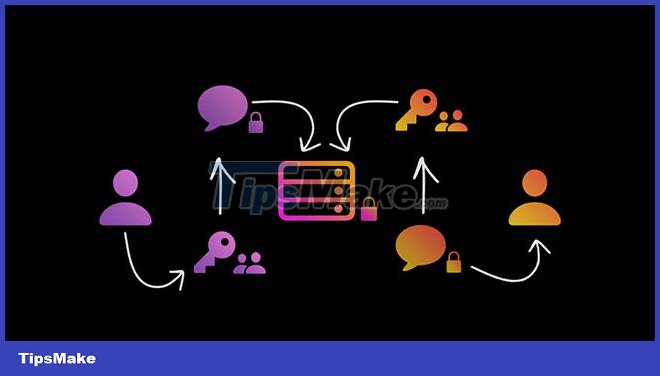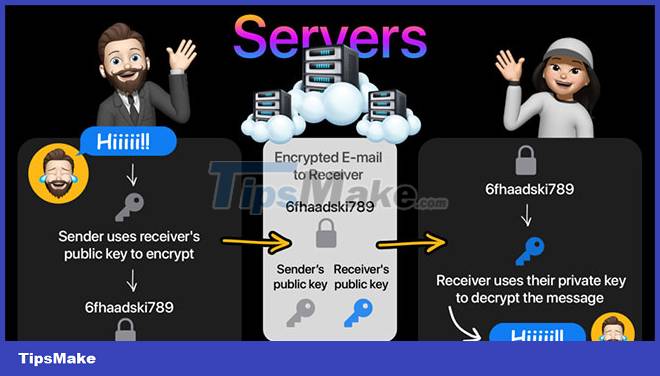What is end-to-end encryption? How does it work?
Aware of this need, the major online messaging services use a technique known as end-to-end encryption, to secure and protect users' chats.
But what does end-to-end encryption mean and how does it actually work? Let's find the answer through the following article!
What is end-to-end encryption?
You encrypt the message/image to be sent and it travels over the Internet as a 'secret' code. Only the receiver can then decrypt this 'secret' code. This process is called end-to-end encryption.

In the simplest terms, end-to-end encryption ensures confidential communication between the sender and receiver, preventing third parties from accessing this information. The tools and technologies that help with this process are designed into messaging apps and other software that users (may) use.
How does end-to-end encryption work?
The goal of end-to-end encryption is to prevent any intruder from stealing information between the sender and receiver. Back to the situation mentioned earlier: You are sending someone else a message.
When using an end-to-end encryption service, you are provided with a public and private key pair. These keys help you encrypt and decrypt. Along with that, the messaging app has an algorithm, consisting of mathematical functions used to encrypt or decrypt data.
When you're sending someone a message, you'll be provided with a public key that maps to that person's chat box. The public key is used to encrypt the message, using an algorithm found in the messaging app. This public key helps you recognize the recipient's device and the fact that he or she will receive the message.

Now, the recipient will use the private key, which helps to decrypt the message and interpret the information in the message sent by you. This private key is only available and exclusive to the recipient's device. Therefore, no one else can decrypt the message - at this point, the end-to-end encryption has succeeded.
This is the basic operating principle of end-to-end encryption. However, not all services use end-to-end encryption. Some tools often use transport layer encryption instead. So what is the difference between these 2 techniques.
What is the difference between end-to-end encryption and transport layer encryption?
As mentioned earlier, not all services are end-to-end encrypted. But, that doesn't mean they don't have any means of encryption. The most common form of encryption for websites is TLS - Transport Layer Security encryption.
The only difference between this type of encryption and end-to-end encryption is that in TLS the encryption takes place in the sender's device and is decrypted at the server. Therefore, it is not really end-to-end encrypted but provides a good level of security and is capable of protecting the user's information.

It is also known as encryption in transit. This means that the service provider can access all your messages through their servers. That's why you can easily see your old Instagram messages when you reload the app, but not on WhatsApp. You can only restore messages by downloading the backup file and decrypting it on your device.
Advantages and disadvantages of end-to-end encryption
Here are some advantages of end-to-end encryption.
- Every step is fully protected.
- Servers of messaging services cannot access messages and related information.
- Information cannot be accessed by unauthorized persons online.
- You cannot restore messages through a new login - unless there is an encrypted backup. Consider the Instagram and WhatsApp Messenger messenger example explained above.
Some disadvantages of end-to-end encryption include:
- Metadata such as date, time, and participant names are not encrypted.
- If the endpoints (sender or receiver) are vulnerable, end-to-end encryption doesn't do much.
- In some cases, it can happen despite end-to-end encryption. Therefore, if someone chooses to physically impersonate the sender or receiver, the messages and information can be read by unauthorized people.
Above are all the pros and cons of end-to-end encryption. If you're still wondering whether to enable end-to-end encryption even if you're not sending secret messages, the answer is yes. Why allow others to access your data?
Here's everything you need to know about end-to-end encryption. Hope you found this article useful!
You should read it
- Top 5 best USB encryption software
- Discover the difference between symmetric and asymmetric encryption
- Top 20 best encryption software for Windows
- Adiantum, Google's new encryption method helps ensure safety for all Android devices
- What is data encryption? Things to know about data encryption
- File encryption software and privacy protection messages
- How to enable Full-Disk Encryption on Windows 10?
- How to set up military-grade encryption on Windows 11
May be interested
- How to enable Full-Disk Encryption on Windows 10?
 on windows 10, some use encryption by default, but some do not. in the following article, network administrator will show you how to check if the memory on windows 10 computer is encrypted.
on windows 10, some use encryption by default, but some do not. in the following article, network administrator will show you how to check if the memory on windows 10 computer is encrypted. - How to set up military-grade encryption on Windows 11
 military-grade encryption is a term marketers use to describe aes. aes itself stands for 'advanced encryption standard', a very secure way to encrypt digital data.
military-grade encryption is a term marketers use to describe aes. aes itself stands for 'advanced encryption standard', a very secure way to encrypt digital data. - How to encrypt text using the Text Encryption Tool
 text encryption tool is a text encryption utility with sha-256 algorithm, which helps you quickly encrypt or decode text.
text encryption tool is a text encryption utility with sha-256 algorithm, which helps you quickly encrypt or decode text. - Instructions for USB encryption with VeraCrypt
 usb (removable drive) is a place to store your important files. what will happen if you lose it? the result will be extremely bad so it is better to encrypt your usb. in this article, tipsmake.com will guide you how to simple and effective usb encryption.
usb (removable drive) is a place to store your important files. what will happen if you lose it? the result will be extremely bad so it is better to encrypt your usb. in this article, tipsmake.com will guide you how to simple and effective usb encryption. - How to encrypt email
 if not encrypted, your email is at risk of being hacked and read at any time, or you may lose your account. this article will give you an overview of how to encrypt email, help you understand and choose the right encryption solution.
if not encrypted, your email is at risk of being hacked and read at any time, or you may lose your account. this article will give you an overview of how to encrypt email, help you understand and choose the right encryption solution. - Microsoft changes the default settings to keep the content stored on the hard drive safe
 in june last year, security researchers discovered that the method of securing ssd hard drive encryption could be easily 'broken' ...
in june last year, security researchers discovered that the method of securing ssd hard drive encryption could be easily 'broken' ... - How to back up the EFS file encryption key and certificate in Windows 10
 encrypting file system (efs) is an encryption tool built into windows that is used to encrypt files and folders on ntfs drives, to protect them from unwanted access.
encrypting file system (efs) is an encryption tool built into windows that is used to encrypt files and folders on ntfs drives, to protect them from unwanted access. - Automatically encrypt EFS in Windows XP, Vista or Windows 7
 in the following article, we will show you how to create scripts to automate the efs standard data encryption process of user accounts every time they log in. the purpose of encryption in this way is to protect confidential documents, information of individuals, organizations or companies, then back them up.
in the following article, we will show you how to create scripts to automate the efs standard data encryption process of user accounts every time they log in. the purpose of encryption in this way is to protect confidential documents, information of individuals, organizations or companies, then back them up. - What is the difference between password locking and encryption?
 in cybersecurity, nothing is more important than keeping sensitive information private and safe. everyone should make an effort to do so, from individuals to large organizations.
in cybersecurity, nothing is more important than keeping sensitive information private and safe. everyone should make an effort to do so, from individuals to large organizations. - Google introduced a new email encryption application
 in order to reassure their users about privacy, google has not only released a privacy report but also launched a new full encryption tool.
in order to reassure their users about privacy, google has not only released a privacy report but also launched a new full encryption tool.










 What is Crowdsourced Security?
What is Crowdsourced Security? What is a time-based one-time password (TOTP)? Should I use it?
What is a time-based one-time password (TOTP)? Should I use it? What is Cryptovirology? Is it dangerous?
What is Cryptovirology? Is it dangerous? What is Oracle VirtualBox? What can be done with it?
What is Oracle VirtualBox? What can be done with it? What is the Samsung AMOLED E5 screen?
What is the Samsung AMOLED E5 screen? What is Salami Attack?
What is Salami Attack?